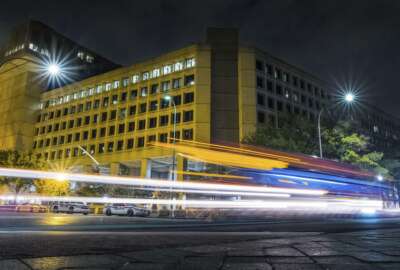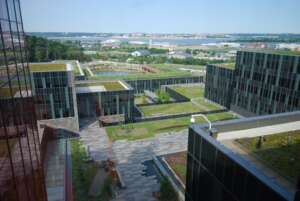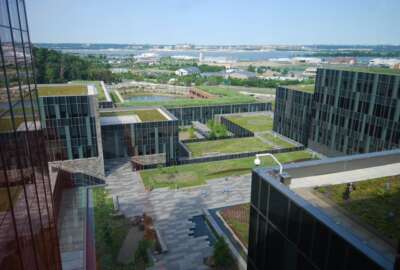

Katy Kale, the acting GSA administrator, said the Federal Green Advisory Committee stepped out in front soon after the EO and created two new task forces—the...
Best listening experience is on Chrome, Firefox or Safari. Subscribe to Federal Drive’s daily audio interviews on Apple Podcasts or PodcastOne.
Green may be the General Services Administration new favorite color. And it’s not about money — this time.
GSA is re-energizing its commitment to green government across its entire portfolio of products and services. The agency further outlined its plans to do its part to battle climate change as required under President Joe Biden’s January executive order.

“One thing that is really important to us at GSA across the board is to be looking at how we can decarbonize our entire supply chain,” said Sonal Kemkar Larsen, the senior adviser to the GSA administrator on climate, during a press briefing on April 20. “We procure a lot of different things: Energy, buildings, government goods and vehicles. In all of those, we need to look at our supply chains, the manufacturers, the businesses we are working with all the way to the design and installation in all of this. There is carbon from the beginning to the end so decarbonization is going to be a big lift as we look across the supply chain. A new focus for us is to look across all aspects of procurement.”
The January order made climate change a national security issue and gave nearly every agency some sort of responsibility.
For example, GSA is one of several members of the National Climate Task Force.
There also is an entire section on using the federal buying power to address climate change, which is where a lot of GSA’s efforts will come into play.
GSA must deliver a plan around clean energy vehicles and green electricity. Its plan was due in April, but the White House extended the deadline to May 27. GSA said they are working on that plan and another one around sustainability that will be out later this summer.
Under the executive order, GSA has to address how it will help achieve:
Two of the biggest focus areas will be around buildings and the fleet of vehicles.
But over the last decade, GSA’s efforts, and really the government writ large, has fallen behind. The progress it made with green government has seriously waned.
Investments in facility efficiency improvements fell by nearly 75% between 2010 and 2019 while renewable electricity usage — which had been on the rise from 2010 to 2016 — declined steadily through 2019. Reductions in governmentwide building energy intensity stagnated over the last four years, which lawmakers have noticed.
Members of multiple climate, energy and oversight committees sent a letter on Jan. 26 to Comptroller General Gene Dodaro, asking the Government Accountability Office to investigate agency noncompliance with the Energy Independence and Security Act of 2007. The letter said that only 21% of buildings covered by the law underwent comprehensive energy and water evaluations, and only 12% are benchmarked.
GSA is taking several steps to reenergize these efforts.
Katy Kale, the acting GSA administrator, said the Federal Green Building Advisory Committee stepped out in front soon after the EO and created two new task forces — the federal building decarbonization task group and the environmental justice and equity task group.
“The decarbonization task group will explore opportunities for reducing greenhouse gas emissions in buildings in the federal real estate portfolio through the use of renewable energy, energy efficiency, electrification and smart building technologies. They will provide some recommendations to GSA this fall so we can begin to develop a roadmap for the decarbonization of federal buildings,” Kale said. “The environmental justice and equity task group will improve engagement with diverse communities and key partners throughout design, construction, operations, renewal and occupancy. We believe this engagement will lead to increased inclusion, opportunities and green jobs in the federal sustainability building process.”
The greening of buildings is a huge opportunity for GSA. The agency said 60% of its leases held are set to expire between fiscal 2019 through 2023. This is the perfect opportunity to push for more green buildings.
“When we are talking about decarbonization in buildings, it’s all of the things that we need to do to reduce and eliminate greenhouse gas emissions that are caused by the operation of the building. That could include replacing gas boilers with solar hot water or using ground source heat pumps,” Kale said. “Really we need to make sure we are including every efficiency measure that we can, including using smaller, more local equipment for heating and cooling, making sure motors are high efficiency motors, adjusting control strategies to reduce peak loads. It’s A to Z, we’ve got everything covered.”
Like buildings, GSA has huge opportunities through the vehicles it manages.
GSA currently oversees 670,000 cars and trucks, most of which agencies own. It also manages more than 200,000 vehicles that are leased.

The investment in clean energy vehicles started several years ago and GSA said its fleet already includes 16 types of battery operated vehicles and 5 plug in hybrid electric vehicles.
Charlotte Phelan, the assistant commissioner for the Office of Travel, Transportation and Logistics in the Federal Acquisition Service, said the fleet is more than just cars but trucks and even school buses.
“The biggest challenge that we are looking at is actually the charging infrastructure. We need to deploy electric vehicle infrastructure to make sure we are able to do large scale vehicle deployment while also ensuring agencies are able to accomplish their mission,” Phelan said. “That, to me, will probably be the most complicated part of it.”
Phelan added GSA hosted roundtables with automotive and charging industries to learn about vehicles and charging infrastructure technology in March. She said a new plan to address this challenge will be out in the next few months.
Sonny Hashmi, the commissioner of the FAS, said the long-term goal is to get to zero emissions over the next several years.
Copyright © 2025 Federal News Network. All rights reserved. This website is not intended for users located within the European Economic Area.
Jason Miller is executive editor of Federal News Network and directs news coverage on the people, policy and programs of the federal government.
Follow @jmillerWFED



